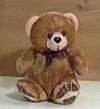Teddy Bears' Picnic
"The Teddy Bears' Picnic" is a song consisting of a melody by American composer John Walter Bratton, written in 1907, and lyrics added by Irish songwriter Jimmy Kennedy in 1932. It remains popular as a children's song, having been recorded by numerous artists over the decades. Kennedy lived at Staplegrove Elm and is buried in Staplegrove Church, Taunton, Somerset, England. Local folklore has it that the small wooded area between the church and Staplegrove Scout Hut was the inspiration for his lyrics.
Background
Bratton composed and personally copyrighted it in 1907, and then assigned the copyright to M. Witmark & Sons, New York, who published it later that year as "The Teddy Bears Picnic: Characteristic Two Step", according to the first page of the published piano score, as well as the orchestral parts Witmark published in an arrangement by Frank Saddler. However, the illustrated sheet music cover gives the title as THE TEDDY BEARS' PICNIC, with apostrophe on "BEARS" and no genre descriptor.[1][2] Irish songwriter Jimmy Kennedy wrote the now familiar lyrics for it in 1932.
After Bratton wrote "The Teddy Bears' Picnic", however, many people felt that the composer plagiarized portions of the melody. Music aficionados pointed out in particular that the refrain echoed the theme from Robert Browne Hall's 1895 "Death or Glory March". Nevertheless, charges were not filed and Bratton's song still has the same tune it had in 1907.
The first recording of the piece was by the Edison Symphony Orchestra, made at Edison Records' "New York Recording Department" studio, 79 5th Avenue, New York, in November 1907 and was released as Edison two-minute cylinder 9777 in March 1908, as announced on page 3 of the January, 1908 issue of The Edison Phonograph Monthly (vol. VI, no. 1).[3][4] Arthur Pryor's Band made the work's first disc recording for the Victor Talking Machine Company in Camden, New Jersey, on 14 September 1908. Take 2 from that session was released in November 1908 as Victor single-faced disc 5594 and as side A of the company's first double-faced disc 16001, with the title on the label reading "The Teddy Bears' Picnic/Descriptive Novelty".[5][6] An early UK recording was made by the Black Diamonds Band for Zonophone records in 1908.
The first vocal version was recorded in 1932 on BBC Radio by Henry Hall with his BBC Orchestra, with Val Rosing singing Kennedy's lyrics. The song was subsequently recorded by Lucy Diner, Bing Crosby (recorded 22 June 1950),[7] The Nitty Gritty Dirt Band, Rosenshontz, Frank DeVol, Rosemary Clooney, Dave Van Ronk, Jerry Garcia, John Inman, Trout Fishing in America, Anne Murray, Michael Feinstein[8], Ray Ellington, and Drastic Measures.
In popular culture
- In the late 1940s and early 1950s a version performed by organist Ethel Smith was used as the theme song for the Big Jon and Sparkie radio program, a children's show presented on weekdays and Saturday mornings. The Saturday show was later named No School Today.
- John Inman's 1975 recording of the song (as featured on his first album Are You Being Served Sir?) was regularly playlisted on BBC Radio 1/2 Saturday morning children's show Ed Stewart's Junior Choice in the late 1970s.
- In 1983 Green Tiger Press turned Kennedy's lyrics into a children's book, with illustrations by company co-founder Sandra Darling (under the name Alexandra Day). Original printings included a 7" record, with the Bing Crosby recording on the A side, and a recording by a local klezmer band, dubbed "The Bearcats", on the B-side.
- In 1989, a short film entitled The Teddy Bears' Picnic was released, featuring two teddy bears named Benjamin (voiced by Jonathan Crombie) and Wally (voiced by Stuart Stone) attending the said picnic. Ann Stevens performed the song, which served as the film's theme song. Two other films based on the film were released called The Teddy Bears' Christmas (1992) and The Teddy Bears' Scare (1998) and later a television series called The Secret World of Benjamin Bear.
Use by BBC radio engineers
The 1932 Henry Hall recording was of especially good quality with a large tonal range. It was used for more than 30 years by BBC audio engineers (up until the early 1960s) to test and calibrate the frequency response of audio equipment.[9]
References
- 1st edition copy of piano version at Lilly Library, Indiana University http://webapp1.dlib.indiana.edu/inharmony/detail.do?action=detail&fullItemID=/lilly/devincent/LL-SDV-092037
- Front cover of the piano score: http://fedora.dlib.indiana.edu/fedora/get/iudl:338274/SCREEN
- "TRUESOUND FIRMENDISCOGRAPHIEN". www.truesoundtransfers.de.
- https://archive.org/details/edisonphonograph06moor Edison also re-recorded it in June 1909 for four-minute wax Amberol cylinder 255, released in October of that year (as announced in the EPM, vol. VII no. 8, August 1909, p. 20), and reissued that as four-minute celluloid Blue Amberol cylinder 1867 in September 1913 ("Blue Amberol Regular List", EPM, vol. 11 no. 7, July 1913).
- "Victor matrix B-6405. Teddy bears' picnic / Arthur Pryor's Band - Discography of American Historical Recordings". victor.library.ucsb.edu.
- "Victor 16001 (Black label (popular) 10-in. double-faced) - Discography of American Historical Recordings". victor.library.ucsb.edu.
- "A Bing Crosby Discography". BING magazine. International Club Crosby. Retrieved 13 September 2017.
- "Pure Imagination". 21 April 1992 – via Amazon.
- Ades, David; Bickerdyke, Percy; Holmes, Eric (July 1999). This England's Book of British Dance Bands. Cheltenham: This England Books. p. 9. ISBN 0-906324-25-4.
External links
- The Teddy Bears' Picnic on YouTube (sung by Val Rosing, 1932)
- The Teddy Bears' Picnic on YouTube (sung by Bing Crosby, 1950)
